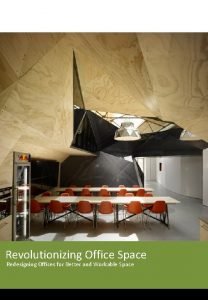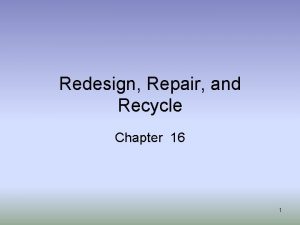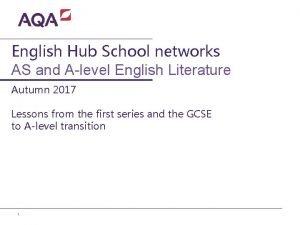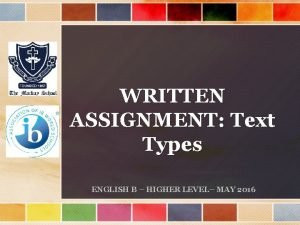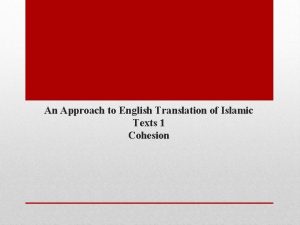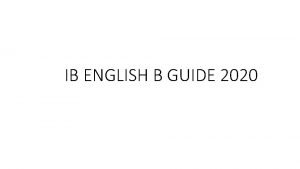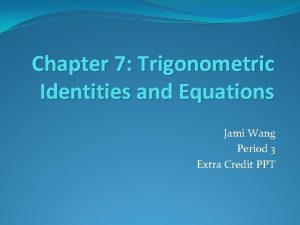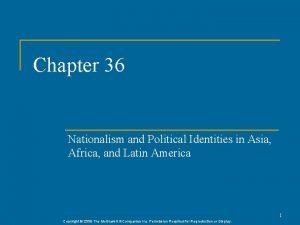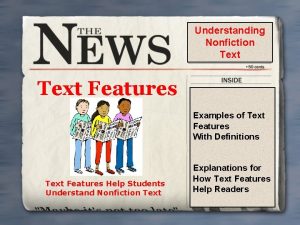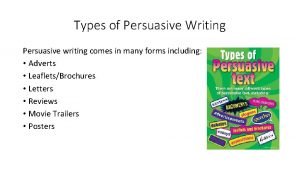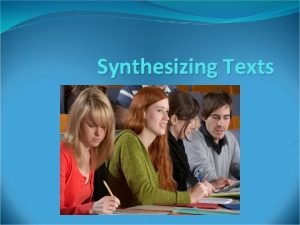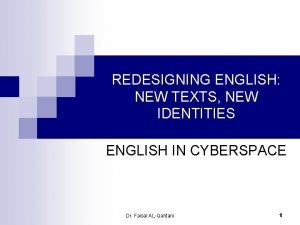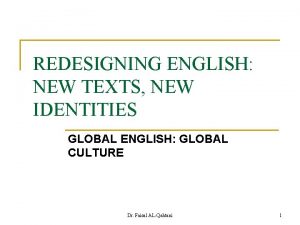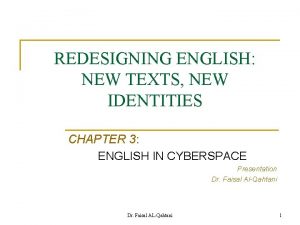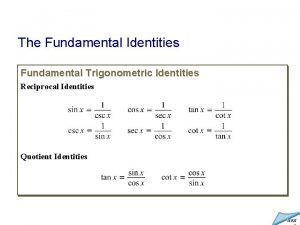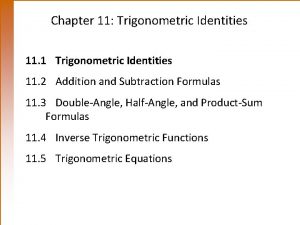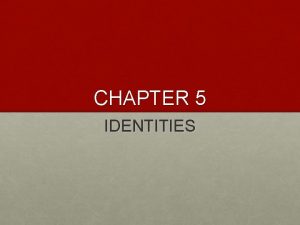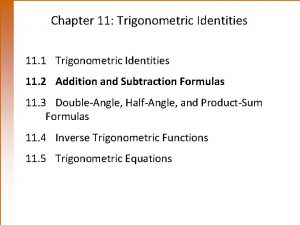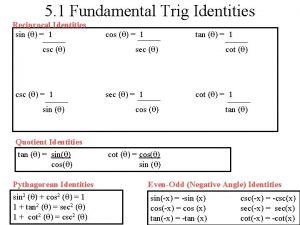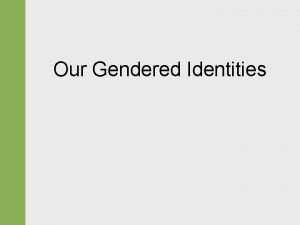REDESIGNING ENGLISH NEW TEXTS NEW IDENTITIES CHAPTER 2













- Slides: 13

REDESIGNING ENGLISH: NEW TEXTS, NEW IDENTITIES CHAPTER 2: VISUAL ENGLISH Presentation Dr. Faisal Al-Qahtani Dr. Faisal AL-Qahtani 1

FOCUS n Forms of visuals used to communicate in English. n Visual forms of communication: q culturally specific and highly conventionalized. n Ways in which graphics and pictures can communicate. n Differences between Visual English and Verbal English. n Visual and verbal English interaction q reinforce each other, or q create conflicting meanings. Dr. Faisal AL-Qahtani 2

VISUAL AND VERBAL LITERACIES: The Impact Of Technology Visual literacy: n Traditional definition of literacy: q inadequate to define visual English. n English texts: q multimodal and increasingly visual with the help of the new technology: n q different semiotic mode of communication. Culture, language and ‘seeing’ n q Context: crucial for meaningful decoding of visual English. q Visual English: culturally based. q Different languages and cultures: different symbols. Dr. Faisal AL-Qahtani 3

VISUAL OR VERBAL ENGLISH n Graphosemantics: q meaning which derives from the text writtenness: n n what is written and how it’s written and the relationship between the two. Spelling: q Orthography can affect the way in which sounds are perceived: n n q q Grey vs. gray. The semiotics of typography The effect of the typeface of a text: see page 46 -7. Typography has paralinguistic function: n intonation, change of pace, and accents Visual alliteration q n visual alliterative: visual repetition : Own it now on video Visual puns: q n T-shirt, U-turn: links between letters and look-alike objects. Dr. Faisal AL-Qahtani 4

ELEMENTS OF ENGLISH VISUAL GRAMMAR Visuals contain grammatical structures. n Functional approach: q n Analysis of images based on the functional theory of language (Michael Halliday). n The functional approach is useful: it adds a semantic dimension to the analysis of the text: allows differences in meanings: q § Between different ways of addressing people: Mr. Smith or John. § Between different ways of describing events. Some analysts of visual representation take a similar view: q § Dr. Faisal AL-Qahtani Visual representation of events is linked to our point of view about those events, and what we want to communicate about them. 5

ELEMENTS OF ENGLISH VISUAL GRAMMAR n Halliday’s communicative (meta-)functions: Semiotic mode (words, pictures, sounds) can q fulfill three communicative functions: n Ideational – representing ideas n Interpersonal – representing relationships n Textual – combining and integrating the ideational and interpersonal meanings into a text Dr. Faisal AL-Qahtani 6

Direct and Indirect Address: n Both language and pictures: direct and indirect address : q Verbal: n Does the verbal language address the listener or reader directly, q i. e. through the use of second person you? § Visual: n Does the image address the viewer directly, q § Dr. Faisal AL-Qahtani i. e. the person in the poster looking at the viewer? (fig. 2. 13, p. 54) 7

Given-New Structures: n Given information: already known to the participants q n New information not already known, e. g. q n Tense, nervous, headache? Take Anadin (medicin ad. ) (see p. 55). n In images (visual): q given and new are represented spatially through left and right positioning or before and after images. Dr. Faisal AL-Qahtani 8

Victors: Visual Transitivity n Transitivity (Hallidayan approach): q a set of choices for representing what is going on in the world: representational elements: n q q n n Processes: action, transaction, or event. Participants: the entities involved with what is going on: actor and goal. Different representations depend on the writer and on the context: e. g. , q event: innocent villagers died. q (instead of) transaction: soldiers killed innocent villagers. Visual Transitivity: q Above examples can be represented in images (p. 57). Dr. Faisal AL-Qahtani 9

Modality: Visualizing the “real” (degree of representing reality) n Modality (Halliday): expressions of comment or attitude by the speaker: q high modality expression: high truth value: n I know he is coming. q n n Low modality expression: he might come. Modality can be expressed visually: q q A sharply detailed, fine grained photograph = high modality: more true/real No detail = low modality Dr. Faisal AL-Qahtani 10

VISUAL NARRATIVES: n Multimodal narratives employ multimodal features: Paralinguistic features q n e. g. facial expressions, gestures and postures. Proxemic indicators: q n i. e. how characters are positioned (closeness, distances). Pictorial representation: cartoons: q n e. g. stars after a bump, or light bulb to show that one has a great idea. Intonation: q n e. g. characters’ accent, pitch, stress… Dr. Faisal AL-Qahtani 11

VISUAL NARRATIVES: n Visual Deixis: references to time and place q Visual shapes n q q show deictic expressions like then and now. q Color: present events q black and white: past events. Different languages and cultures express visual narrative structures in different ways. Dr. Faisal AL-Qahtani 12

CONCLUSION: Texts are becoming increasingly multimodal: q n employing visual and verbal semiotic modes. Meanings ascribed to visual information: q n socially constructed and culturally dependent. Dr. Faisal AL-Qahtani 13
 Redesigning office space
Redesigning office space Redesigning the organization with information systems
Redesigning the organization with information systems Redesigning old clothes
Redesigning old clothes Aqa english literature nea prohibited texts
Aqa english literature nea prohibited texts Text types english b
Text types english b An approach to english translation of islamic texts
An approach to english translation of islamic texts 5 ib themes
5 ib themes Chapter 35 nationalism and political identities in asia
Chapter 35 nationalism and political identities in asia Tan 240⁰
Tan 240⁰ Chapter 36 nationalism and political identities in asia
Chapter 36 nationalism and political identities in asia Informational texts examples
Informational texts examples Types of persuasive writing
Types of persuasive writing Shannon bumgarner
Shannon bumgarner Text to reported speech
Text to reported speech
